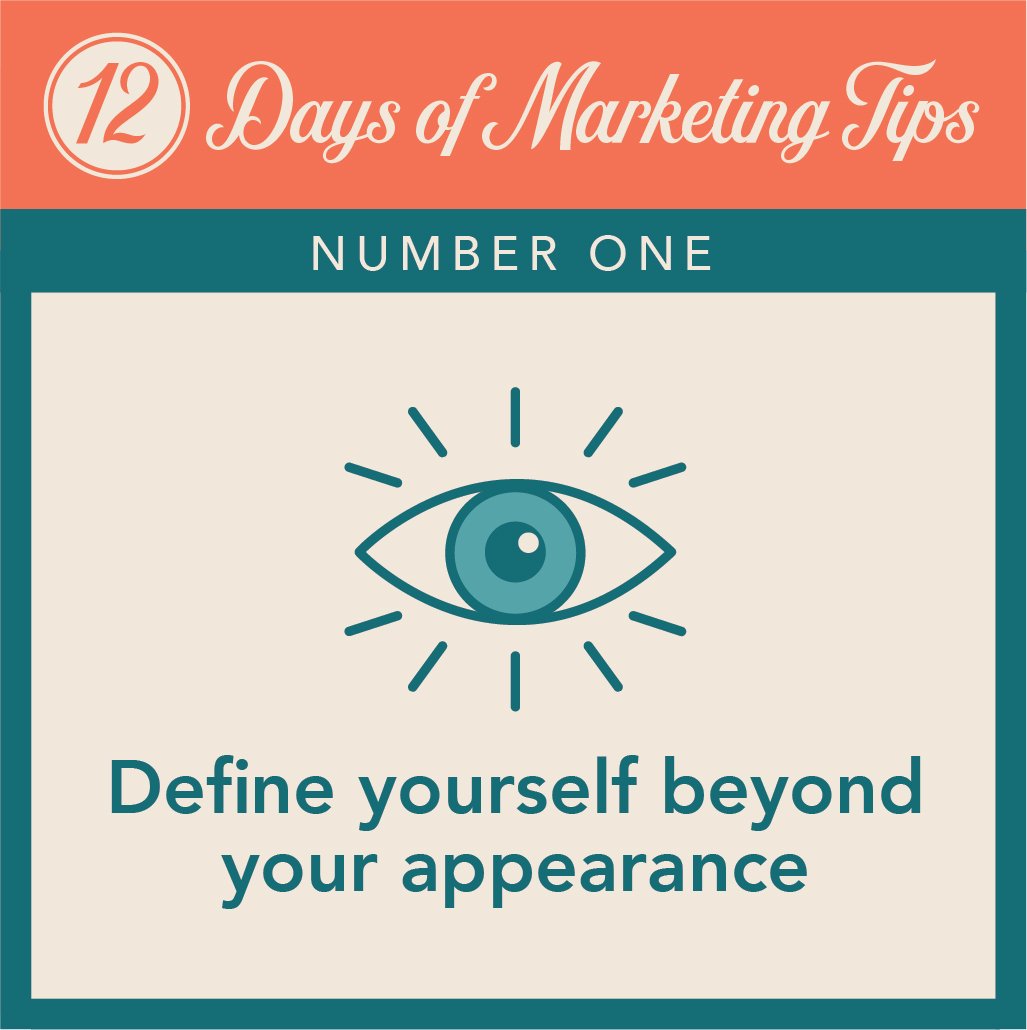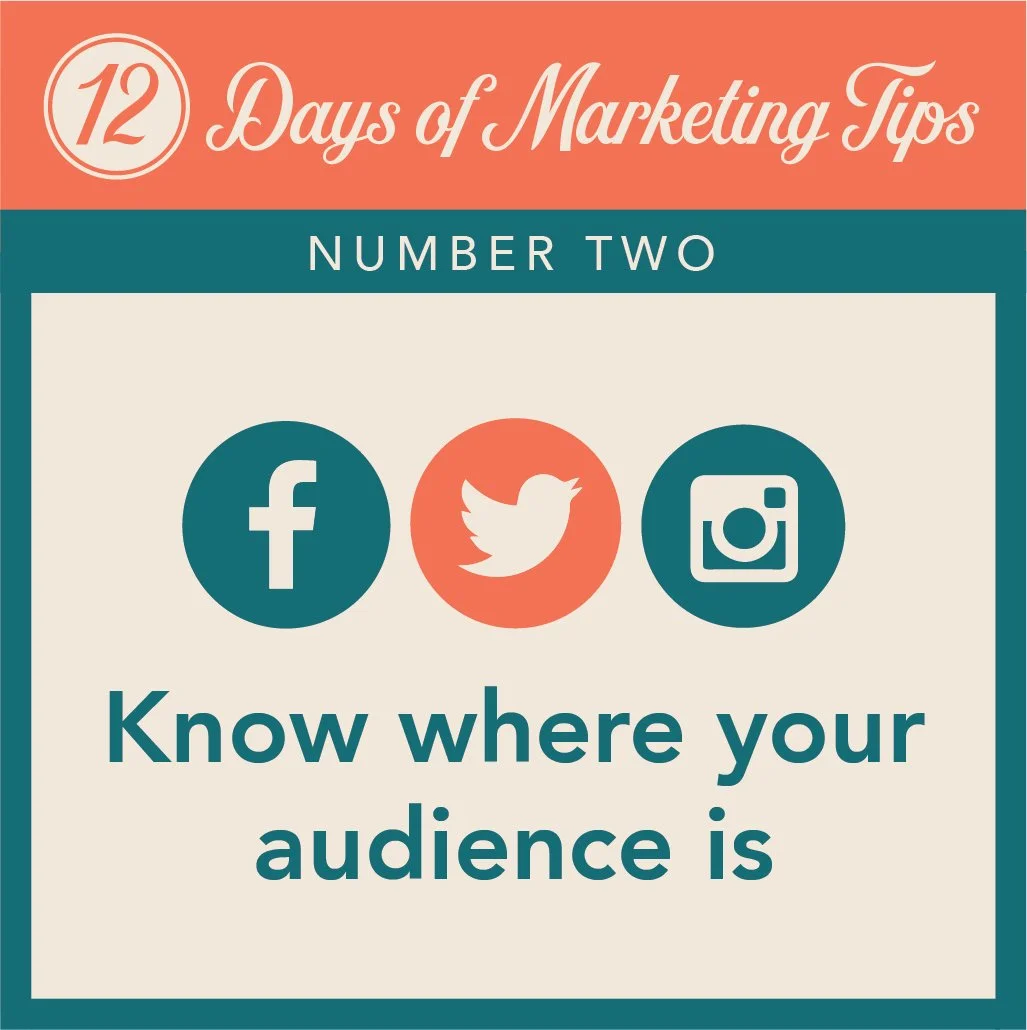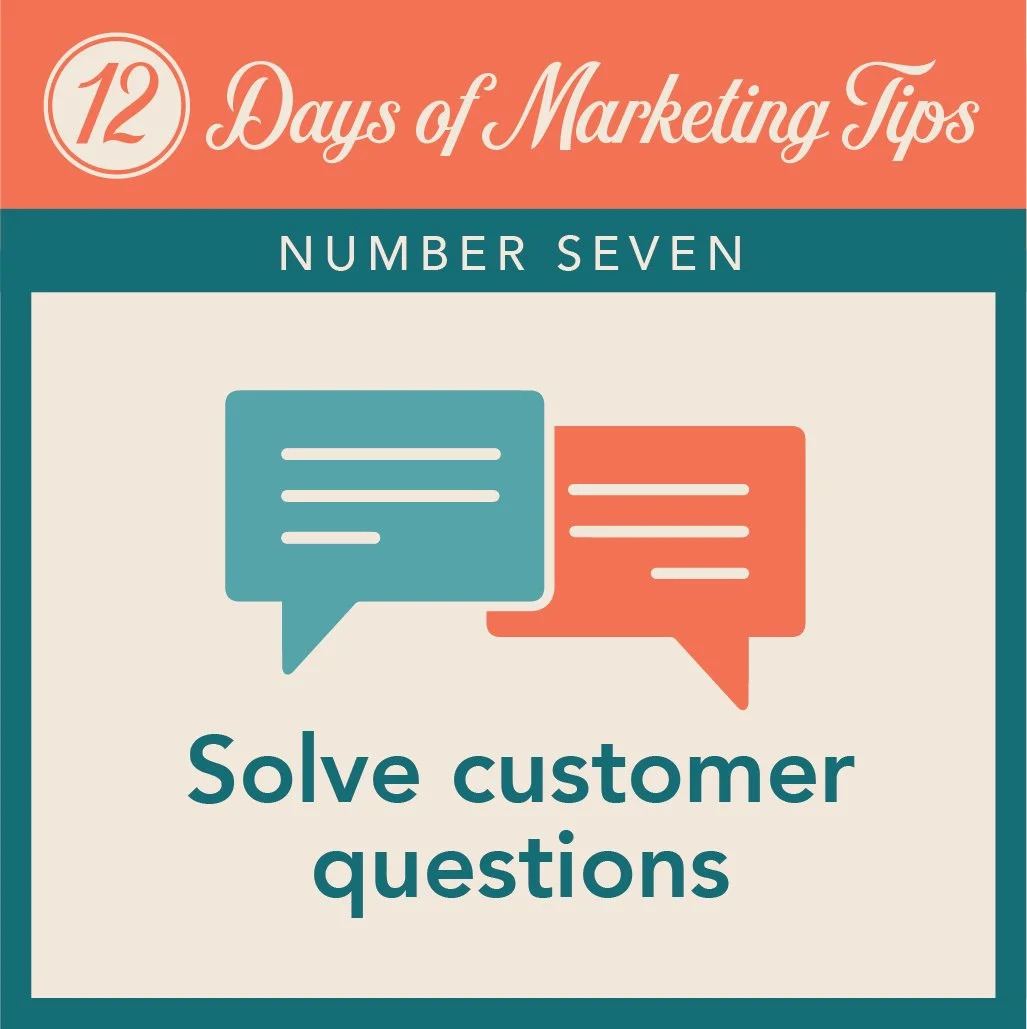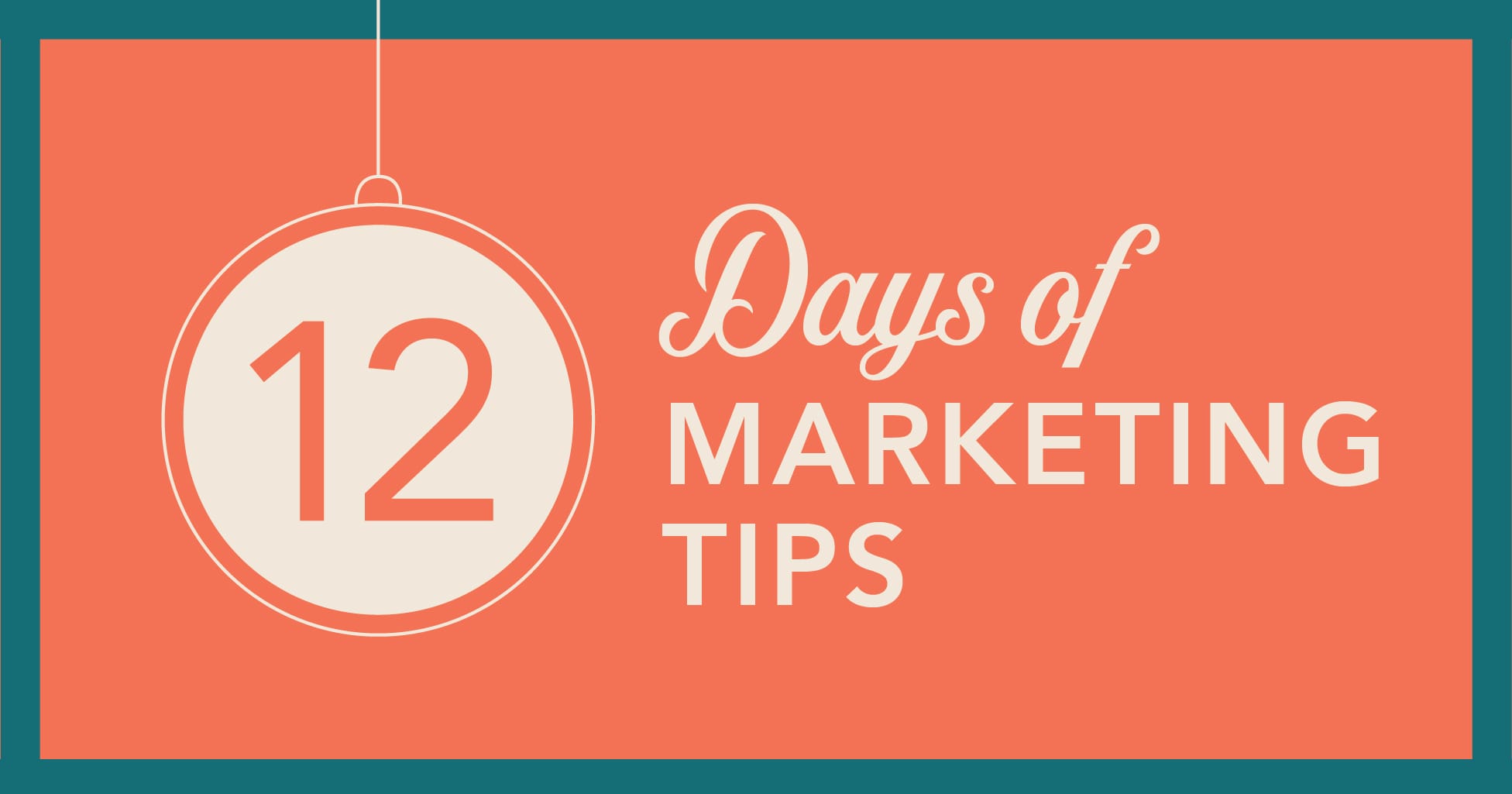Instead of gifting our followers 184 birds like the traditional 12 Days of Christmas (seriously, so many birds!), we shared something more useful this holiday season: 12 Days of Marketing Tips! For the past 12 days on our Instagram and LinkedIn, we’ve been sharing actionable marketing advice to help businesses improve their marketing strategy in the new year. The tips range from brand identity to social media to SEO and everything in between.
Because we know some people are already checked out for 2022, we’re reposting the advice below so you can reference it any time of year – holiday spirit not required.
And if you’re looking to level up your marketing with a little less DIY, you can schedule a consultation call with us anytime.

Tip 1: Brand Identity – Define yourself beyond your appearance
Your brand is more than just the visible elements, such as a logo, set of colors, and fonts. These visual cues are important to distinguish you in the marketplace, but your brand is more than just a pretty face. Your brand is also a sum of stories, values, and personality — like how here at The Marketing Dept. we live by our core value of authenticity and being unapologetically ourselves. Your brand identity is also what others say about you and the feelings they are left with after interacting with you.

Tip 2: Social Media – Know where your audience
It might feel like you need to jump on the latest social media network, but before you start twerking for TikTok, consider the demographic you’re looking to reach with your business.
- Facebook: Millennials through Boomers, majority female, best for building brand loyalty and relationships with your customers
- Twitter: Gen X and Millennials, majority male, best for public relations and sharing news
- Instagram: Millennials, best for lead generation and telling visually-based stories
- LinkedIn: Industry-based professionals, best for sharing company news, job opportunities, and major accomplishments
- Pinterest: Millennials, majority female, best for lead generation and SEO boosts for narrow interest base
- TikTok: Gen Z, best for building brand loyalty and community and sharing how-to or educational content.
- YouTube: Everyone! Another search engine, it’s best for brand awareness and lead generation
We’re all about trying new strategies to extend your reach, but a dormant or outdated social media account is more detrimental to your business than not being on every single platform. Prioritize the social media you have time to maintain well and that matches your target market.

Tip 3: SEO – Write for humans first and search engines second
Your content strategy should be focused on answering questions of your customers — which means you should make sure the content you write is understandable by humans. By writing with people in mind, your writing will be more natural and will be rewarded by Google (yes, really!). Search engines are getting smarter every day and reward websites that provide quality content that answers the queries people are searching for. Stuffing keywords in a non-sensical way isn’t going to get more visits to your website.
While there’s technical adjustments you can make to content to improve searchability, the core of SEO is about writing for your users. Afterall, the Google bots aren’t the ones walking into your storefront or using your service!

Tip 4: SEM – Waiting for SEO efforts to show? Pay for instant gratification
We are believers that #ContentIsKing in web marketing, but SEO requires patience as a long-term strategy. While you’re waiting for the organic traffic to start rolling in, we advise investing some $$$ to search engine marketing (SEM) to boost traffic in the short-term.
SEM guarantees quick web traffic and is easier to quantify ROI. Measure short-term wins while waiting for those long-term wins of SEO to pay off (trust us – they will!)
So next time you finish writing a killer blog article or crafting a key landing page, open the checkbook for some instant gratification of web views with SEM.

Tip 5: Design – Embrace less is more
By keeping things simple, you’re better able to direct your customer’s attention to the main element or idea that you’re trying to convey. If you try to squeeze too much information or design elements onto one graphic, brochure, or advertisement, you’re less likely to get your key message across.
Embrace white space and keep designs focused on functionality. Simplicity and elegance never go out of style! We’ve all seen cringe-worthy, over-designed advertisements. Don’t let your business be guilty of bad design.

Tip 6: Email – Perfect your subject line
Your email subject line is the MOST important copy you write in an email because if your customers aren’t intrigued enough to open, the rest of the email doesn’t matter. If you’ve been reading our “Understanding the Sales Funnel” series, you know that email offers are a key example of bottom-of-the-funnel (BOFU) marketing. Emails help you convert people into paying customers and crafting the best subject line is the first step:
- Keep it short! Oftentimes, people check their emails from their mobile devices and long subjects are cut off. Put your most important phrases in the front
- Avoid spam words and overly promotional language (like “buy now” or screaming in all caps) to keep your email out of the junk folder
- Say something unexpected or tease the content to hook your readers and spark their interest
Give your email subject lines a little extra attention and see how those open rate numbers change in the new year.

Tip 7: Blogging – Solve customer questions
One of the best ways to start an online content strategy is to brainstorm a list of questions most commonly asked by customers. Each of those questions can be answered in a blog post.
You might be asking — how is this different than an FAQ page?
Blogs offer the depth that people (and Google!) are looking for. People don’t just want answers to their questions; they want explanations. Through a well-written blog, you can educate customers, earn their trust, debunk misinformation, and position your company as the experts you are.
Content marketing should provide value to customers. What’s more helpful than getting your questions answered?

Tip 8: Social Media – Plan ahead with a content calendar
Content calendars, particularly with social media, will save you time and ensure that you can take time off to spend time with your family and friends during the holiday season.
(They are pretty helpful the rest of the year, too!)
In addition to saving you time, content calendars help keep you organized, allow you to post timely and relevant content, and ensure consistency in publishing. Plus, a regular posting cadence on social media is preferred by the algorithms.
Here are a few quick tips to get started building a content calendar:
- Identify content buckets (think beyond your product categories and instead think content topics that would engage your followers)
- Set a posting cadence (how often do you want to post and on which platforms?)
- Review often (there’s no definitive answer to how far in advance you should plan content, but you should monitor often so you can stay nimble with your content decisions)
A content calendar is standard for the social media work we do for our clients and ourselves.

Tip 9: Local SEO – Start with Google My Business
When was the last time that you Googled a store or restaurant to see if it was open? If you said anything besides “this morning,” we don’t believe you.
That handy Google snippet at the top of search results that gives quick information about hours, location, and contact information is powered by Google My Business. Every business is able to create a free profile to control the information that shows up first when someone Google’s your business name. Not only can you ensure that your business hours are accurate and that GPS directions send customers to the right place, you also boost your visibility on Google search for any search that has “near me” in the query.
For businesses that serve a local community, a Google Business Profile isn’t just a good idea — it’s a must.

Tip 10: Video – Just do it
Take a note from Nike’s playbook about video.
Just do it.
We know how intimidating video seems, but the rise of TikTok, Reels, and YouTube should be enough proof of why it is so important for business. Video builds trust and engages even the laziest of buyers. Even if you don’t have the budget or expertise to create a super polished cut, a simple recording of your people explaining a topic or demoing a product will go a long way in encouraging customers.
Plus, there’s a bunch of research that shows that the time spent creating a video is worth the ROI.
Start small (we’re talking 30 seconds!) and give video marketing content a whirl.

Tip 11: Podcasting – Talk directly to a niche audience
Here’s a compelling reason to create a podcast: you can talk directly to a niche audience.
- Roughly 120 million Americans are podcast listeners
- Over 50% of podcast episodes are between 20 and 60 minutes long
- 30% of new podcast listeners search the internet to find new shows
- 60% of podcast listeners have bought something from a podcast ad
Podcast listening is continuing to grow in popularity – especially with millennials – and they offer a unique opportunity to engage your audience on a deeper level. While there are some challenges to telling a purely audio-based story, the medium also gives you a direct ear to your ideal community. With a small investment of recording equipment, you can build rapport with your customers while they drive their morning commute, walk the dog, or cook dinner.
We partner with the video production crew at Drew Loewen Creative to serve our clients with top notch videography and podcasting, too! They will ensure that your audio is clear and professionally edited so your listeners can focus on your wisdom and not background noise.

Tip 12: Livestreaming – Broadcast your event to reach more people
Webinars and livestreamed events are a great way to expand the reach of your content.
Webinars are no longer niche business seminars for salespeople. Thanks to the pandemic, people around the nation are more willing to engage in online events like webinars for all sorts of topics and industries.
Webinars are a great bottom-of-the-funnel marketing strategy to nurture leads into customers — especially for service-based businesses. By hosting an event or product demo, you’re allowing potential customers to experience your service and ward off buyer’s regret. Plus, online broadcasts can be saved and repurposed as video content later (and we already talked about how important video marketing is!)
It goes without saying, but the Drew Loewen Creative team works with us on webinars and live-casting, so you know the set up will go up without a hitch.









